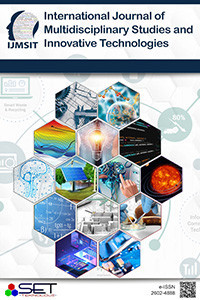Mobil Cihazlar İçin RFID & Bluetooth Düşük Enerji Teknolojisi İle Öğrenci Yoklama Sistemi Tasarımı
Yoklama sistemi, Sensörler, RFID, Bluetooth LE, BLE
Design of Student Attendance System with RFID & Bluetooth Low Energy Technology for Mobile Devices
Attendance system, Sensors, RFID, Bluetooth LE, BLE,
___
- [1] M. Mattam, S.R.M. Karumuri, and S.R.Meda, “Architecture for Automated Student Attendance,” in Proc. IEEE Fourth International Conference on Technology for Education (T4E 2012), pp.164-167, 18-20 July 2012
- [2] C.B.Chew, M.M-Singh, K.C.Wei, T.W.Sheng, M.H.Husin, N.H.A.H.Malim, “Sensors-enabled Smart Attendance Systems Using NFC and RFID Technologies”, International Journal of New Computer Architectures and their Applications (IJNCAA) 5(1): 19-28, 2015
- [3] V.D Hunt, A.Puglia and M.Puglia, A Guide to Radio Frequency Identification, New Jersey, John Wiley & Sons, Inc., Hoboken, 2007.
- [4] H.Lehpamer, RFID Design Principles, 2nd ed., Norwood:Artech House, 2012.
- [5] S.Ahson, M.Ilyas, RFID HandBook: Applications, Technology, Security, and Privacy, CRC Press is an imprint of Taylor & Francis Group, an Informa business, United States of America, 2008.
- [6] K. Finkenzeller, Fundamentals and Applications in Contactless Smart Cards, Radio Frequency Identification and Near-Field Communication, 3rd ed, United Kingdom, Wiley, 2010.
- [7] D. Schmidt, RFID im Mobile Supply Chain Event Management Anwendungsszenarien, Verbreitung und Wirtschaftlichkeit, Gabler Verlag, Wiesbaden, 2006.
- [8] N.Gupta, Inside Bluetooth Low Energy, United States of America, Artech House, 2013.
- [9] R.Heydon, Bluetooth Low Energy The Developer’s Handbook, United States of America, Pearson Education, Inc, 2013.
- [10] M.U.Aftab, Building Bluetooth Low Energy Systems, Birmingham, Packt Publishing, 2017.
- ISSN: 2602-4888
- Yayın Aralığı: Yılda 2 Sayı
- Başlangıç: 2017
- Yayıncı: SET Teknoloji
Mobil Cihazlar İçin RFID & Bluetooth Düşük Enerji Teknolojisi İle Öğrenci Yoklama Sistemi Tasarımı
Cengiz ÖZCAN, Fazıl SARAY, Mustafa TARI
Heating System Application with Ground Source Heat Pump for Isparta Climate Conditions
Osman İPEK, Mohammed ALKHALIDI, Mehmet KAN, Barış GÜREL, Sedeeq ALOMARİ
Mustafa TARI, Şakir TAŞDEMİR, Cengiz ÖZCAN, Ayşe TARI
ASTM F75 Co-Cr-Mo alaşımının abrasiv aşınma davranışlarının araştırılması ve incelenmesi
Arsalan ALAMDARİ İLKHCHİ, Mahmut İZCİLER
Ahmet Doğukan YAZICI, Mehmet DAŞ
Salt MOSFET filtrelerde gürültü performansların incelenmesi¥
Design, Analysis and Prototyping of the Combined Heating and Cooling System with Solar Energy
Osman İPEK, Sedeeq ALOMARİ, Barış GÜREL, Mehmet KAN, Mohammed ALKHALIDI
